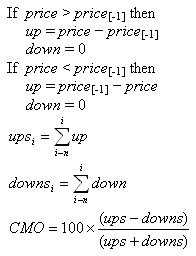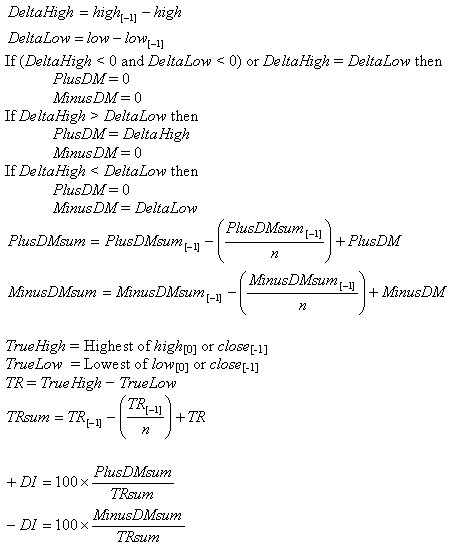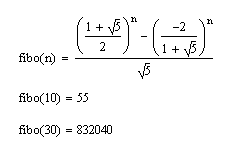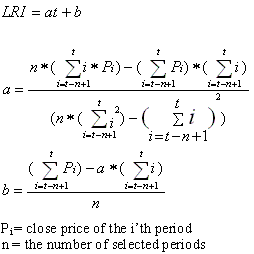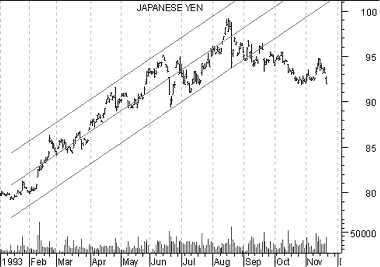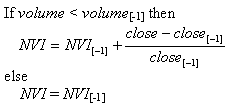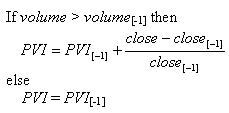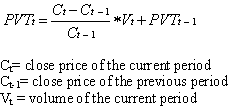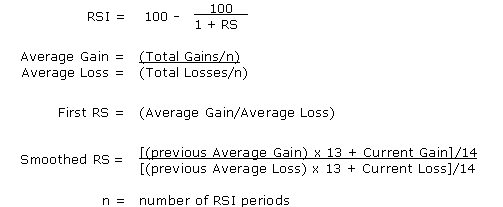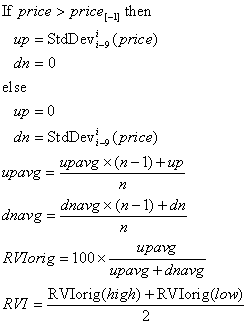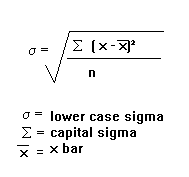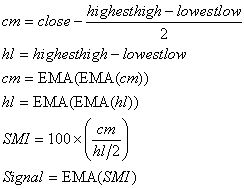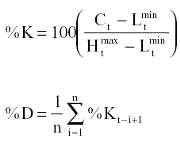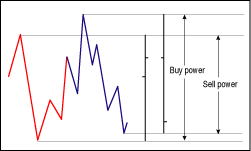Editors Note:
Although this is not an idicator it is a fairly singificant
usage pattern that almost makes SF backtesting usable.
Thank you Cegis for the great insight that you continually provide.
--------------------------------------------------------------------
Original Post
cegis 9/17/2004 5:23:18 PM
This is a discussion of a technique that I (cegis) developed
a few months back, and has seemed to be useful regularly in
other threads ever since. So, I decided to document it, in
the hope it will be of use to others.
This technique allows you to calculate returns for a filter,
for any time period, and (almost) any assumed trading "program".
What StockFetcher offers as basic site functionality is a
column labeled "Performance" when showing results from a
filter that has the "offset" phrase. The performance shown
(I think - correct me if I'm wrong) is based on the closing
price of the stock on the day that the stock matched the
filter (the offset date) and yesterday's close. This means
that the period covered by the column changes with the offset.
You can also get the 1 day, 2 day, 3 day, 4 day, one week,
two week, etc. performance for the filter's results by
clicking on the Performance column header, and "browsing
through the dates" (assuming there have been that many
trading days in the offset period). This is good, but limiting.
The scenarios that SF's Performance functionality does not
take into account are things like "performance for a 10 day
period, regardless of the start date", "worst case performance"
using the day-after-match's high and end-of-period low as
entry/exit points, or "trading program rules" such as max
loss of 2%. This technique allows such analysis.
The "trick" to this technique is to use the "days ago" phrase
instead of the "offset" phrase. This allows you to "see what
happened" AFTER the stocks matched your filter. As an example,
if you use "offset 10 days", SF will not allow you to retrieve
("see") values from what would be "offset 9 days". However,
if you use "10 days ago", you can always analyze what happened
"9 days ago".
Let's look at a simple example. We'll assume our starting filter is:
rsi(2) is less than 1
and price is between 1 and 10
and average volume(25) is greater than 100000
If we run this filter on Sat. 9/25/04 (which will be our assumed
run date for all of the following discussion), we'll see the
results for 9/24 market close. Now, let's assume we want to
see how this filter performed based on picks from 10 days ago.
If we use
rsi(2) is less than 1
and price is between 1 and 10
and average volume(25) is greater than 100000
offset 10 days
we'll get selections for 9/10, and we'll get the Performance
column talked about above (9/10 to 9/24, close to close), as
standard SF functionality. However, if we wanted to see what
a "worst case" scenario would have been, we would not be able
to access the data for 9/11's high or 9/24's low to make this
determination. However, if we instead used
rsi(2) 10 days ago is less than 1
and price 10 days ago is between 1 and 10
and average volume(25) 10 days ago is greater than 100000
we'll still get the results of our original filter as of 9/10,
but now we can calculate our worst case scenario:
set{myrtn,low - high 9 days ago}
set{myrtnp,myrtn / high 9 days ago}
set{wcrtnpct,myrtnp * 100}
rsi(2) 10 days ago is less than 1
and price 10 days ago is between 1 and 10
and average volume(25) 10 days ago is greater than 100000
add column high 9 days ago {entry}
add column low {exit}
add column myrtn {profit}
add column wcrtnpct {profit percent}
Since all of our conditions have "10 days ago", the first
set{} command is "looking into the future" to get the following
day's high (high 9 days ago), and the 10th day's low
(low [0 days ago]), to calculate the return ($). The other two
set{}s just convert the first set{} into a percentage. (I'm
using my entry as the basis for the percentage...) The add
columns will show us our result.
Note that the return calculated will ALWAYS be a ten-day
return. We can continue to backtest this filter by adding
an "offset" too!
set{myrtn,low - high 9 days ago}
set{myrtnp,myrtn / high 9 days ago}
set{wcrtnpct,myrtnp * 100}
rsi(2) 10 days ago is less than 1
and price 10 days ago is between 1 and 10
and average volume(25) 10 days ago is greater than 100000
add column high 9 days ago {entry}
add column low {exit}
add column myrtn {profit}
add column wcrtnpct {profit percent}
offset 1
With the offset 1, we'll actually match stocks for 9/9, and
show what the 10 day return is through 9/23. You can then
alter the offset to continue backtesting other dates. In
other words, you do NOT have to keep changing the "days ago"
in order to backtest prior dates. Just remember that SF will
report "results as of 9/24" (or whatever your offset would
suggest) at the top of the results list, and you have to
remeber that you used "days ago" to shift the data back an
additional 10 days.
Also note that you can calcualte multiple returns for the
period covered by the "days ago" offset:
set{myrtn10,low - high 9 days ago}
set{myrtn10p,myrtn10 / high 9 days ago}
set{wc10rtnpct,myrtn10p * 100}
set{myrtn5,low 5 days ago - high 9 days ago}
set{myrtn5p,myrtn5 / high 9 days ago}
set{wc5rtnpct,myrtn5p * 100}
rsi(2) 10 days ago is less than 1
and price 10 days ago is between 1 and 10
and average volume(25) 10 days ago is greater than 100000
add column wc5rtnpct
add column wc10rtnpct
Here, we added a claculation of the 5 day worst case scenario,
in addition to the 10 day return.
This can be taken one step further (this is where this gets
REALLY interesting!) by using "logical variables" to actually
implement a "trading program". (Logical variables are discussed
in several other threads, so I'm not gonna go into them here...)
Let's say that you want a 2% trailing stop, and you'll hold
for a max of 3 days. (I'll discuss this day limit later.)
We'll assume we enter at the opening price, and exit at our
stop or 3 day close. We'll also assume we only adjust our
stop once a day based on the open. This filter will show you
how well you would do:
set{limit1,open 2 days ago * 0.98}
set{in1,count(low 2 days ago is greater than limit1,1)}
set{stopped1,1 - in1}
set{out1,stopped1 * limit1}
set{limit2, open 1 day ago * 0.98}
set{in2,count(low 1 day ago is greater than limit2,1) * in1}
set{stopped2a,1 - in2}
set{stopped2,stopped2a * in1}
set{out2,stopped2 * limit2}
set{limit3, open * 0.98}
set{in3,count(low is greater than limit3,1) * in2}
set{stopped3a,1 - in3}
set{stopped3,stopped3a * in2}
set{out3,stopped3 * limit3}
set{out3c,close * in3}
set{outa,out1 + out2}
set{outb,outa + out3}
set{out,outb + out3c}
add column open 2 days ago {in}
add column out1
add column out2
add column out3
add column out3c
rsi(2) 3 days ago is less than 1
and price 3 days ago is between 1 and 10
and average volume(25) 3 days ago is greater than 100000
So here, out1, out2, out3, and out3c will show you your exit
price if you exit on the first, second, or third days, or at
the close of the third day (respectively). They will be ZERO
if you did not exit on that day. Thus, you can see when you
would have exited, as well as how well you would have done.
There are two things I would have liked to do in the prior
filter, but SF limits how many times you can "nest" set{}
statements (that is, base one set{} on the results of another).
I would have liked to change the calculation of limit2 and
limit3 so that it only goes up in value (a trailing stop),
as well as calcaulte the $ and percentage return based on my
exit price. I would have also liked to check for "green hold"
(high 2 days ago > close 3 day ago) before considering myself
"in". However, this filter sits right at the edge of the SF
nesting limit, so I was unable to do that. That's also why I
chose a three day maximum hold period.
One way to get around this, somewhat, is to show results for
every day (instead of figuring out if you would have been
stopped), like this:
set{limit, open 9 days ago * 0.98}
set{profit1, high 9 days ago * 0.98}
set{profit2, high 8 days ago * 0.98}
set{profit3, high 7 days ago * 0.98}
set{profit4, high 6 days ago * 0.98}
set{profit5, high 5 days ago * 0.98}
set{profit6, high 4 days ago * 0.98}
set{profit7, high 3 days ago * 0.98}
set{profit8, high 2 days ago * 0.98}
set{profit9, high 1 days ago * 0.98}
add column open 9 days ago {in}
add column limit
add column low 9 days ago {low1}
add column profit1
add column low 8 days ago {low2}
add column profit2
add column low 7 days ago {low3}
add column profit3
add column low 6 days ago {low4}
add column profit4
add column low 5 days ago {low5}
add column profit5
add column low 4 days ago {low6}
add column profit6
add column low 3 days ago {low7}
add column profit7
add column low 2 days ago {low8}
add column profit8
add column low 1 days ago {low9}
add column profit9
rsi(2) 10 days ago is less than 1
and price 10 days ago is between 1 and 10
and average volume(25) 10 days ago is greater than 100000
Now, you can read across the columns, and if you assume you
use 2% below the high as the following day's stop, all you
have to do is read across the columns to see where a "low"
value is less than the prior column (profit or limit) to see
where you would have been stopped out.
This isn't perfect, but it can get you some useful information!
Things to Consider
==================
• The number of days you want to use in the "days ago" phrase
is the maximum holding period (or days worth of data you need)
to calculate your returns. You do not want to use a larger number.
• If your filter compares to prior days (ie, something like
"open is greater than close 1 day ago"), you want to ADD
the number of days in this calculationally-based days ago
to the condition's days ago (in this case, making it something
like "open 10 days ago is greater than close 11 days ago").
• Note that the days ago prevents you from running the backtest
as of a date "closer" to today than the number of days ago
used. I do not consider this a major limiting factor.
• SF will report "Filter results for [day of week] [date]".
This will be based on the offset, not your days ago, value.
You just need to remember that you have programmed an
additional offset into the filter for backtesting purposes.
• Whenever I use this technique, I first copy the filter that
I want to backtest, then modify it to do the calculations
and use the days ago that I need. You don't really want to
use days ago (in the manner described here) in a filter
you're gonna actually select stocks from...
• Depending on your trading conditions and return calculations,
you may be able to use the count() and sum() functions,
and/or the "[n] days high" / "[n] days low", to look at
longer time frames than the three days as in the example.
• If you are backtesting a weekly filter, use "weeks ago"
instead of "days ago". Also, funky things will happen
if your filter mixes weekly and daily indicators.
(Basically, the "days ago" and "offset" are not quite
equivalent due to the way SF handles weekly values...)
• Remember that you can download the results into a spreadsheet,
and then use that to extend the backtest based on any
logic you couldn't get into the filter.
Hope this helps,
C
|

 Learn More
Learn More

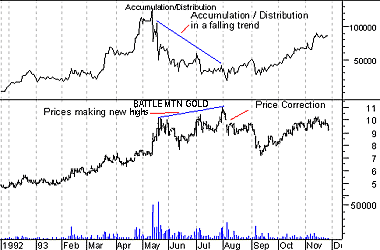




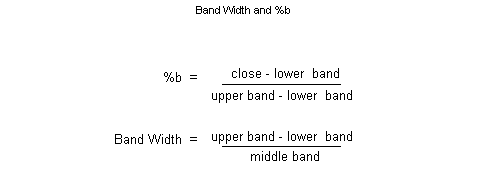



 •pattern is Bullish Upside Tasuki Gap
•pattern is Bullish Upside Tasuki Gap •pattern is Bullish Side-by-Side White Lines
•pattern is Bullish Side-by-Side White Lines •pattern is Bullish Separating Lines
•pattern is Bullish Separating Lines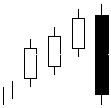 •pattern is Bullish Three Line Strike
•pattern is Bullish Three Line Strike •pattern is Bullish Upside Gap Three Methods
•pattern is Bullish Upside Gap Three Methods •pattern is Bullish Harami Cross
•pattern is Bullish Harami Cross •pattern is Bullish Three Outside Down
•pattern is Bullish Three Outside Down •pattern is Bullish Three Inside Up
•pattern is Bullish Three Inside Up •pattern is Bullish Homing Pigeon
•pattern is Bullish Homing Pigeon •pattern is Bullish Harami
•pattern is Bullish Harami •pattern is Bullish Morning Doji Star
•pattern is Bullish Morning Doji Star •pattern is Bullish Tri-Star
•pattern is Bullish Tri-Star •pattern is Bullish Meeting Lines
•pattern is Bullish Meeting Lines •pattern is Bullish Unique Three Rivers
•pattern is Bullish Unique Three Rivers •pattern is Bullish Abandoned Baby
•pattern is Bullish Abandoned Baby •pattern is Bullish Matching Low
•pattern is Bullish Matching Low •pattern is Bullish Engulfing
•pattern is Bullish Engulfing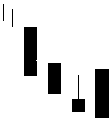 •pattern is Bullish Concealing Baby Swallow
•pattern is Bullish Concealing Baby Swallow •pattern is Bullish Three White Soldiers
•pattern is Bullish Three White Soldiers •pattern is Bullish Kicking
•pattern is Bullish Kicking •pattern is Bearish Side-by-Side White Lines
•pattern is Bearish Side-by-Side White Lines •pattern is Bearish In Neck
•pattern is Bearish In Neck •pattern is Bearish Separating Lines
•pattern is Bearish Separating Lines •pattern is Bearish Three Line Strike
•pattern is Bearish Three Line Strike •pattern is Bearish Downside Gap Three Methods
•pattern is Bearish Downside Gap Three Methods •pattern is Bearish Thrusting
•pattern is Bearish Thrusting •pattern is Bearish On Neck
•pattern is Bearish On Neck •pattern is Bearish Harami Cross
•pattern is Bearish Harami Cross •pattern is Bearish Three Outside Up
•pattern is Bearish Three Outside Up •pattern is Bearish Three Inside Down
•pattern is Bearish Three Inside Down •pattern is Bearish Harami
•pattern is Bearish Harami •Bearish Evening Doji Star
•Bearish Evening Doji Star •pattern is Bearish Tri-Star
•pattern is Bearish Tri-Star •pattern is Bearish Meeding Lines
•pattern is Bearish Meeding Lines •pattern is Bearish Advance Block
•pattern is Bearish Advance Block •pattern is Bearish Identical Three Crows
•pattern is Bearish Identical Three Crows •pattern is Bearish Abandoned Baby
•pattern is Bearish Abandoned Baby •pattern is Bearish Two Crows
•pattern is Bearish Two Crows •pattern is Bearish Engulfing
•pattern is Bearish Engulfing •pattern is Bearish Dark Cloud Cover
•pattern is Bearish Dark Cloud Cover •pattern is Bearish Three Black Crows
•pattern is Bearish Three Black Crows •pattern is Bearish Kicking
•pattern is Bearish Kicking •pattern is Bearish Deliberation
•pattern is Bearish Deliberation •pattern is Hanging Man
•pattern is Hanging Man

